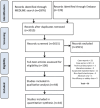Endoscopic sleeve gastroplasty (ESG): indications and results-a systematic review
- PMID: 39875745
- PMCID: PMC12540582
- DOI: 10.1007/s13304-025-02097-1
Endoscopic sleeve gastroplasty (ESG): indications and results-a systematic review
Abstract
Obesity is a major global health problem and at the same time a financial burden for social security systems. For a long time, conventional lifestyle interventions have tried unsuccessfully to find a solution. It has been proven that only interventions that ultimately address the central control centers of hunger, appetite and satiety will lead to sustained weight loss. As a result, metabolic and bariatric surgery (MBS) has become the gold standard in the treatment of obesity and has been shown to be effective and safe in both the short and long term. Processed via the gut-brain axis, MBS not only leads to weight loss, but also-and, in addition, independently through the modification of the intestinal tract in bypass surgery-to a significant remission rate of type 2 diabetes mellitus, the typical co-morbidity of obesity. However, MBS is not suitable for all patients. Some patients are ineligible due to a high-risk profile or do not wish to undergo surgery, whilst others do not meet the criteria for MBS but still suffer from obesity. This treatment gap has been a driving force behind the development of endoscopic solutions such as endoscopic sleeve gastroplasty (ESG). ESG offers a less invasive, endoluminal and anatomy-sparing alternative that reduces gastric volume by suturing tissue folds along the greater curvature. Such a reduction in gastric volume, which is also one principle of action of MBS, can induce earlier satiety and lead to weight loss. The evidence behind this procedure, in particular its efficacy and safety, should be objectified through this review.
Keywords: Bariatric endoscopy; Endoscopic sleeve gastroplasty; Excess weight loss; Long-term results; Obesity; Primary weight loss procedure; Safety.
© 2025. The Author(s).
Conflict of interest statement
Declarations. Conflict of interest: BAD has served as a consultant for Boston Scientific, Metamodix, BFKW, DyaMx, and USGI Medical; has received research support for Boston Scientific, Apollo Endosurgery, USGI, Spatz Medical, GI Dynamics, Caim Diagnostics, Aspire Bariatrics, and Medtronic; and has been a speaker for Johnson & Johnson, Endogastric Solutions, and Olympus. CS has served as a consultant for Boston Scientific, USGI Medical, NovoNordisc, Johnson & Johnson, Lohmann & Rauscher, Morphic Medical, Trans.Duodenal.Concepts, and Cranax Medical Digestive. The other author declared no conflict of interest. Research involving human participants and/or animals and Informed consent: Not applicable.
Figures



References
-
- Finkelstein EA, Khavjou OA, Thompson H et al (2012) Obesity and severe obesity forecasts through 2030. Am J Prev Med 42:563–570 - PubMed
-
- Eisenberg D, Shikora SA, Aarts E et al (2022) 2022 American Society for Metabolic and Bariatric Surgery (ASMBS) and International Federation for the Surgery of Obesity and Metabolic Disorders (IFSO): Indications for Metabolic and Bariatric Surgery. Surg Obes Relat Dis 18:1345–1356 - PubMed
Publication types
MeSH terms
LinkOut - more resources
Full Text Sources
Medical
Research Materials
Miscellaneous

